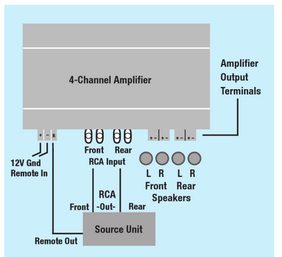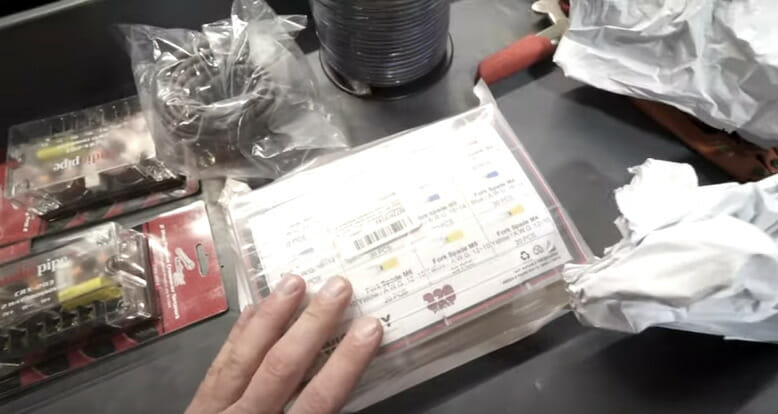How to Wire 8 Speakers to a 4-Channel Amp

A 4-channel amplifier is designed to operate up to 4 speakers, where each channel powers one speaker, but it’s technically possible to wire it to 8 speakers.
You can wire 8 speakers to a 4-channel amp (2 speakers per channel) in parallel or series.
- In a parallel arrangement, connect the positive and negative speaker wires from one channel to the corresponding terminals of the first speaker in the pair. Then, connect the same terminals of both speakers.
- In a series arrangement, connect the positive speaker wire from one channel to the positive terminal of the first speaker and the negative wire to the negative terminal of the second speaker in the pair. Then, connect the remaining opposite terminals of both speakers.
Finally, repeat one of the above patterns for the other 3 channels and the remaining pairs of speakers.
Continue reading for more detailed instructions and wiring diagrams.
More About 4-Channel Amplifiers
4-Channel amplifiers are commonly wired in vehicles to power the standard four speakers.
So vehicle owners with more than 4 speakers would likely want to know how to connect their amp to accommodate the extra speakers. But it’s also a common scenario in home theatre systems.
The audio signals from a 4-channel amp is called quadrophonic sound. It provides a more immersive “surround sound” experience than stereo (2-channel) sound.

Wiring 8 Speakers to a 4-Channel Amp
Power Output and Impedance
Always match the speakers with the amplifier.
Before wiring 8 speakers to a 4-channel amp, consider the amplifier’s power output and speakers’ impedance. It’s important to ensure good sound quality and avoid damaging the audio equipment.
A low speaker impedance can cause the amplifier to overheat and fail, and a low amplifier output can cause sound distortion.
Wiring Arrangement
There are two ways to wire 8 speakers to a 4-channel amp, either in parallel or series and each has benefits and drawbacks.
We will connect the speakers in pairs regardless of the configuration. So, two speakers will connect to each channel.
A series arrangement is generally workable and easy to make. The speakers’ lower power output makes it ideal for connecting many speakers together.
However, a parallel arrangement is usually better as it helps to keep the impedance low and power output high. Connecting multiple speakers to the same channel divides the power output between them, resulting in lower overall volume.
In short, a parallel arrangement will give you better performance.
Wiring Diagram
Here is a wiring diagram for connecting 8 speakers in parallel (2 speakers per channel), our recommended method (instead of a series arrangement or unequal number of speakers per channel).

Note that the positive (+) wire is red, and the negative (-) wire is black.
Requirements
You will need the following to wire the amplifier to the speakers:
- Main items: 4-channel amplifier, 8 speakers
- Tools: wire stripper, wire crimper
- Materials: electrical tape
- Instruments: ohmmeter (or multimeter set to ohms)
- Wires: speaker wires (must be good quality), RCA adapter cable

Wiring 8 Speakers to a 4-Channel Amp in Parallel
A parallel wiring configuration will reduce the total impedance of the speakers and increase the power delivered to each speaker.
Step 1: Strip the Wires
Strip approximately half an inch of the insulation off the ends of the speaker wires using a wire stripper.
Step 2: Attach the Wires to the First Speaker
Insert the positive speaker wire from one amplifier channel to the first speaker’s positive terminal in one pair of speakers and its corresponding negative wire to the first speaker’s negative terminal.
Step 3: Connect the Next Speaker
Connect the same (positive to positive and negative to negative) terminals of the two speakers in the first pair together, as shown in the wiring diagram.
Step 4: Repeat the Pattern
Repeat steps 2 and 3 for the remaining pairs of speakers by wiring them from the next channel (pair of positive and negative wires from the amplifier), as shown in the wiring diagram.
Wiring 8 Speakers to a 4-Channel Amp in Series
Wiring the speakers in series is an alternative to wiring them in parallel, although wiring in parallel is preferable.
A series wiring configuration will increase the total impedance of the speakers and reduce the power delivered to each speaker.
Wiring Diagram
We will follow this wiring diagram to wire 8 speakers to a 4-channel amp in series, sticking to the same pattern of 2 speakers per channel for an equal load distribution.

Step 1: Strip the Wires
Strip approximately half an inch of the insulation off the ends of the speaker wires using a wire stripper.
Step 2: Attach the Wires to the First Speaker
Insert one of the positive wires from the amplifier to the FIRST speaker’s positive terminal in the first pair of speakers. Connect the corresponding negative wire (of the same channel) to the LAST speaker’s negative terminal. Refer to the above wiring diagram.
Step 3: Connect the Next Speaker
Connect the remaining opposite terminals of the two speakers to each other until you’ve connected both speakers to the first channel (pair of positive and negative wires). Refer to the above wiring diagram. It doesn’t matter what color wire you use in this step.
Step 4: Repeat the Pattern
Repeat steps 2 and 3 for the next pair of speakers by wiring them from the amplifier’s next channel (pair of positive and negative wires) until you’ve wired all 4 pairs of speakers from the 4 channels.
Impedance
I mentioned that impedance is an important consideration when wiring multiple speakers together and that a parallel arrangement reduces the total impedance, whereas a series one increases it.
However, a series arrangement also reduces the power output to each speaker, whereas a parallel one delivers the maximum, assuming the output voltage remains the same. This also means that a parallel arrangement increases the amplifier’s current demand.
Calculating Impedance
To work out the impedance:
Add the individual impedances of each speaker connected in series. For example, if each speaker is a 4-ohm one, the total impedance in each pair (connected to each channel) will be (4+4) 8 ohms.
Half the impedance of the speaker is connected in parallel with the other. This assumes both speakers have the same impedance. For example, if each speaker is a 4-ohm one, the total impedance in each pair (connected to each channel) will be (4/2) 2 ohms. The formula is different for unequal impedances.
References
Studies:
- Jason Syner. How to Install Automotive Mobile Electronic Systems. MotorBooks International. 2009
Video References:
Cfilms
